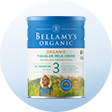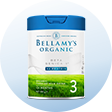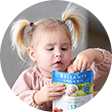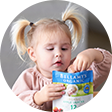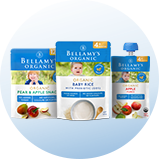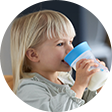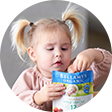Is Your Baby a Fussy Eater, Or Is There an Underlying Issue?
Toddlers can be notoriously fussy eaters, with almost half of young children going through a phase of pickiness with food. Fussiness generally starts at around the age of 1, and peaks at around 3 years of age. So, if this sounds like your toddler, rest assured that many parents are with you.
What is fussy eating?
Fussy eating is classified as refusing to try a new food at least half of the time. There are many types of fussy eating behaviour. For more information on the different types of eating difficulties in children, see The Royal Children’s Hospital.
So, what causes fussy eating?
There are multiple reasons why your child might be a fussy eater. These include:
- how they were milk fed
- delayed introduction of ‘lumpy’ foods (semi-solids such as soft cooked vegetables)
- limited variety of foods introduced
- parent or carer feeding styles e.g. spoon-feeding vs baby-led weaning
- role modelling
- mealtime environments e.g. pressure to eat
If you feel some of these reasons may have poorly influenced your child’s eating. Don’t stress, below are some tips and strategies to help.
How to help a fussy eater?
Strategies and tips:
1. Be a good role model: children naturally copy, so if your child watches you eat what’s on their plate, they are more likely to follow suit.
2. Nurture your child’s sense of independence: give your child 2-3 options such as “which pasta shape would you like today?” or “would you like carrots or cucumber with dinner tonight?”.
3. Create a positive, happy environment: Enjoy mealtimes together as a family and remove distractions like phones and the TV.
4. Make meals fun and exciting: foods with a variety of colours, shapes and sizes are more likely to draw your child’s interest.
5. Set a time limit of 20 minutes for mealtimes: children have short attention spans, so after 20 minutes take their food away and don’t offer alternatives until the next scheduled meal/snack time.
6. Encourage self-feeding from a young age: let them use a spoon, fork or their hands themselves (and do your best to ignore the mess!). Also encourage them to touch, smell and lick new food.
7. Get your kids involved in food preparation: this gives them time to familiarise themselves with the food before it’s time to eat it.
8. Offer healthy foods regularly and repetitively: science shows a child needs to be presented with a food 10-15 times before they deem it safe enough to eat.
9. Give plenty of praise for good eating habits: a hug or excited smile goes a long way. Star charts can be used for children over 3.
10. Don’t pile up their plate: children have small stomachs (about the size of your fist), so be realistic with their portion sizes. Offer more when they have finished.
11. Give a combination of new and familiar foods in a meal: don’t overwhelm them with a plate full of foods they haven’t tried. Pair a new food with foods they know and like already.
12. Try to ignore fussy eating behaviour: sometimes children just want a reaction out of you! Stay calm and give them your full attention while they eat.
When should you seek help?
Key flags indicating you will need professional help include:
- stuck on a particular texture
- fewer than twenty foods they’ll eat
- rejecting an entire food group altogether
- lacking energy or lethargic
- faltering in growth (crossing down percentiles on growth chart over time)
- appearing unwell
- chewing or swallowing difficulties
- choking or vomiting when eating
Don’t forget, your child is allowed to have foods they don’t like, just like you! Dealing with a fussy eater is tricky, but it’s how your toddler learns about new foods and is a normal part of their development. Also, for the first few months of their life, they only consumed milk. That’s a big adjustment! So just be consistent and patient with them and remember; it’s usually a passing phase. This information has been provided as general advice only. If you are concerned about your child’s nutrition or eating habits, always consult your GP, paediatrician, or Healthcare Professional.
References
1. Cardona Cano, Sebastian et al. "Trajectories Of Picky Eating During Childhood: A General Population Study". International Journal Of Eating Disorders, vol 48, no. 6, 2015, pp. 570-579. Wiley, Available at: https://onlinelibrary.wiley.com/doi/abs/10.1002/eat.22384
2. Taylor, Caroline M. et al. "Picky/Fussy Eating In Children: Review Of Definitions, Assessment, Prevalence And Dietary Intakes". Appetite, vol 95, 2015, pp. 349-359. Elsevier BV, available at: https://www.sciencedirect.com/science/article/pii/S0195666315003438
3. Taylor, Caroline M., and Pauline M. Emmett. "Picky Eating In Children: Causes And Consequences". Proceedings Of The Nutrition Society, vol 78, no. 02, 2018, pp. 161-169. Cambridge University Press (CUP), available at: https://www.ncbi.nlm.nih.gov/pmc/articles/PMC6398579/
4. Savage, Jennifer S. et al. "Parental Influence On Eating Behavior: Conception To Adolescence". Journal Of Law, Medicine & Ethics, vol 35, no. 1, 2007, pp. 22-34. Cambridge University Press (CUP), available at: https://www.ncbi.nlm.nih.gov/pmc/articles/PMC2531152/
5. "Five Ways To Help Tackle Fussy Eating » Dietitians Australia". Org.Au, 2021, available at: https://dietitiansaustralia.org.au/smart-eating-for-you/smart-eating-fast-facts/children/five-ways-to-help-tackle-fussy-eating/
6. "Fussy Eating". Raising Children Network, 2021, available at: https://raisingchildren.net.au/toddlers/nutrition-fitness/common-concerns/fussy-eating.
7. Melbourne, The. " Feeding Development And Difficulties : Typical And Problematic Feeding And Mealtime Behaviours ". Org.Au, 2021, available at: https://www.rch.org.au/feedingdifficulties/difficulties/Typical_and_Problematic/
8. Taylor, Caroline M., and Pauline M. Emmett. "Picky Eating In Children: Causes And Consequences". Proceedings Of The Nutrition Society, vol 78, no. 02, 2018, pp. 161-169. Cambridge University Press (CUP), available at: doi:10.1017/s0029665118002586.









